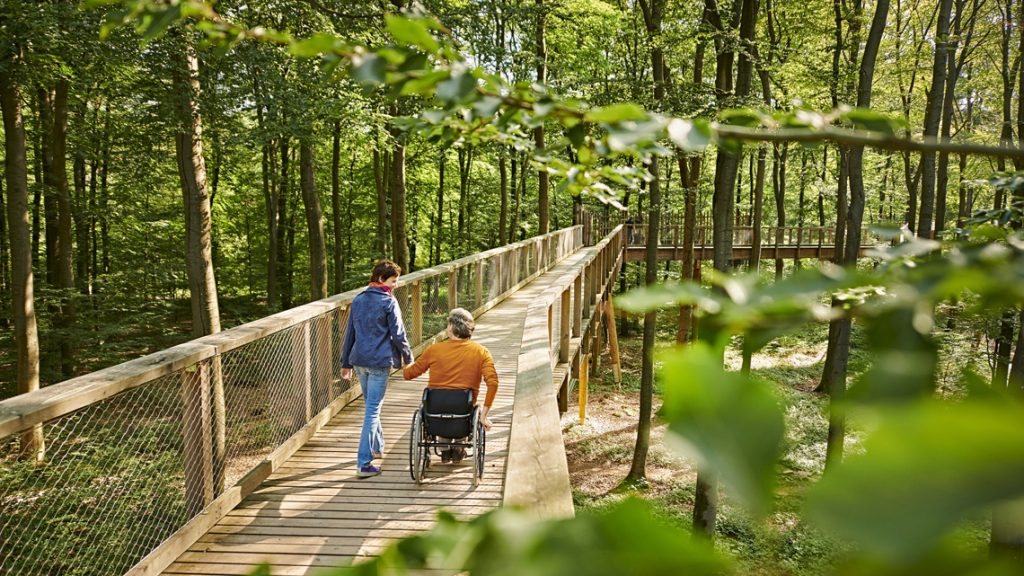This is also possible on the barrier-free canopy walk in the Heinich National Park in Germany! The venue is designed to be completely barrier-free, so people with limited mobility and families pushing strollers will not be left out from this unique experience. Of which? We’ll show you!
In Thuringia, between Bad Langensalsa and Eisenach, the Heinich National Park is one of the most well-guarded wild primeval beech forests in Germany. Does the injured person have the right to walk or take a walk in this German forest and among the foliage? Of course, why not. Can the injured person walk around, walk, come and go in the woods on their own? With a few exceptions, no.
Um, if he has the right, but he can’t do it alone, let’s see it for himself, think it over, plan it, and build it so that the injured person can’t go for a walk in nature. on paper. With this determination, the Germans made the forest unobstructed. If not all, but a good big part. They do it all in such a way that anyone unrelated to accessibility will notice. Passages on which the electric chair can easily roll, or a funnel that amplifies the sound of the forest – within reach of the chair, or a mirror kaleidoscope, showing branches swaying from above to below. Just as you need an accessible light switch in a hotel room, a person using a wheelchair will feel comfortable during the trip if they think about it everywhere. It really happened here: in the Hainich National Park, everything is barrier-free, from parking lots to spotting and feeding wild cats. In the waterblock, birds also chirp in the pigeons, and the wind roars from loudspeakers hidden in several places. Everything is very elegant. Plus it’s a great experience. Who would have thought that the former military exclusion zone is now the largest area of mixed deciduous forest open to visitors in Europe? While skiing is highly recommended in the winter, in spring, summer and autumn the well-marked hiking trails or a walk along the canopy path to the top of the 44-meter-high trees are really attractive. You can reach the top by lift or winding road, protected animal gates welcome the visitor, and many educational boards and activities for children make walking up the high and experiencing the movement of the trees at hand even more enjoyable. .
The largest vase in the world
A castle without barriers? Why not… In Thuringia, wheelchair users with different interests can choose from a wide range of programmes. They can also visit Leuchtenburg Castle, for example. There are few tasks more daunting for a planning architect than renovating, extending and giving access to a medieval castle perched atop a high mountain that has watched over the countryside for centuries, even assuming money is no constraint. Inaccessibility, height, meter-high stone walls, stairs, passages, tunnels, and forts are all attractions that make people think of accessibility as the last thing. However, we managed to make everything so.
The complex of buildings, dating back almost a thousand years, rises about 400 meters above sea level and can be seen from afar, and it is no coincidence that it is called the “Queen of the Valley of Sale”. The place is easily accessible by car, on foot, electric vehicle, bus or train. Leuchtenburg Castle was first mentioned in 1221 as the seat of the Lobdeburg-Leuchtenburg family. It was constantly transformed: around 1460, four bastions were added to it, and in the 18th century it was also used as a prison, workhouse and mental institution. For a time in the 20th century, it housed a youth hostel. In this century, the historic vineyards were replanted and the castle was completely renovated. And in the castle museum, you’ll learn about the material “white gold” made of high-quality porcelain, and how production has changed over time. I wonder why second-rate goods don’t reach stores? This will be revealed here too! If you like, you can write a secret wish on this porcelain using invisible ink, and then throw it into the castle moat of the 20-meter modern killer’s walk, known as the “Wishing Walk”. There from time to time grows a huge pile of broken white plates, which are said to bring good luck. You don’t have to worry about environmental pollution and littering, the process is controlled, and the “lucky pots” are transported and recycled regularly. And what is interesting here? The largest vase in the world, 8 meters high, can be seen in Leuchtenberg. It was created by the artist Alim Besht Han, made of 360 pieces of ceramics resembling honeycombs, supported by ten castle servants in his work, and the ceramics are decorated in blue and gold. The individual pieces were produced at the Reichenbach Porcelain Factory, and today they are one of the main attractions of the exhibition.
Survivor Bendigos












































